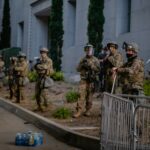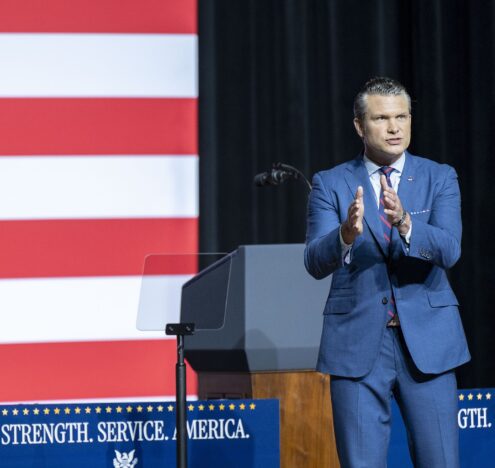“Adults in a Room” is a series in collaboration with The Atlantic Council’s New American Engagement Initiative (NAEI). The series stems from NAEI’s monthly networking events that call on analysts to gather virtually and hash out a salient topic. The goal of this series is to give you a peek into their Zoom room and a deep understanding of the issue at hand in less than the time it takes to sip your morning coffee, without the jargon, acronyms, and stuffiness that often come with expertise.
The Russian invasion of Ukraine on Feb. 24, 2022, has caused a crisis for the US and its allies as they try to respond. There remains significant debate about what the US can and should do, and what this war means for the future of the global order. What means do the US and its allies have to support Ukraine without becoming involved militarily? More significantly, does Russia have larger goals outside of the capture of Ukraine?
The Atlantic Council’s New American Engagement Initiative’s (NAEI) February roundtable brought together a number of experts to discuss Russia’s momentous decision to invade their neighbors and the US response. The participants disagreed on how exactly the US should support Ukraine and how far Russia may go, although there was consensus that the US should not risk a military confrontation with Russia unless a NATO country was attacked. More questions were asked about what this war means for the future of Russia and its relationship with the West — and of course, China.
Four participants expanded on their thoughts on the implications of Russia’s invasion of Ukraine and the US response:
Joshua Rovner, Associate Professor at American University’s School of International Service
So much for the gray zone.
After years of worrying about covert Russian machinations, Russia’s President Vladimir Putin has chosen an overt military intervention to settle his affairs in Ukraine. Armored columns have anonymous hackers. Soldiers with guns have replaced little green men. What are the implications for the current conflict, and our understanding of force and war?
Covert campaigns might be useful for limited objectives, but not for Russia’s outsize goals. The ongoing war suggests that Russia’s leader put too much stock in the gray zone.
Russia’s decision shows that its previous approach failed. It proved a weak tool of coercion against Ukraine, and useless as propaganda against the West. If anything, Russian covert actions during and after the annexation of Crimea came off as particularly sinister, an irony that appears to be lost on Putin himself. All of this suggests the limits of the gray zone. Covert operations, where states try to maintain plausible deniability for their actions, face inherent trade-offs. Ambitious policy goals require a lot of resources to succeed. But increasing these resources — people, organization, money — makes it hard to maintain deniability. Covert campaigns might be useful for limited objectives, but not for Russia’s outsize goals. The ongoing war suggests that Russia’s leader put too much stock in the gray zone.
This doesn’t mean that Putin is learning the right lessons from the last decade. The opposite is more likely. He is taking a reckless action that has breathed new life into NATO and left Russia at risk of economic and diplomatic isolation. It might also increase Russia’s dependence on China, which is not ideal for long-term Russian grand strategy. And it has aroused significant protests at home, both among the Russian population and among some Russian elites.
What happens if Putin is in a corner? One optimistic scenario is that he will back down, seeking a face-saving settlement that allows him to mitigate the costs of the invasion. But Putin’s dubious strategic record suggests a more dangerous future. Rather than negotiating an end to the war, a withdrawal of Russian forces, and a recognition of Ukrainian sovereignty, he might lash out. Putin has already warned the West about intervening in Ukraine, including non-subtle nuclear threats. The danger of escalation is unlikely, given Washington’s stated desire to stay out of the war, but it is not impossible. Western aid will be hard to hide, and Russia is likely to respond aggressively if such aid is imposing real costs. Inadvertent escalation might also occur if fighting spills across borders, or if Western flights inadvertently cross Ukrainian airspace.
Covert action has traditionally been a way to control the risk of escalation. Adversaries tacitly allow one another to conduct covert operations as a kind of release valve; they spend their energies in the shadows in order to reduce the chance of catastrophe. The fact that Putin has moved away from this approach is noteworthy and unsettling.
We might miss the gray zone after all.
Barbara Slavin, Director of the Atlantic Council’s Future of Iran Initiative
Russia’s bloody blitzkrieg into Ukraine has caught many by surprise including Russians who never believed that their country would turn on their closest ethnic cousins. While Moscow clearly has the upper hand for now, in the longer term, Putin may be seriously weakened by this act of aggression and hegemonic overreach. Indeed, some are already predicting that Ukraine will be his Afghanistan, referring to the insurgency that defeated Soviet troops in the 1980s and led to the breakup of the Soviet Union.
As resistance continues in Ukraine, within Russia itself, thousands have protested on the streets of major cities, an act of great courage in a country where dissidents are routinely assassinated, jailed, or exiled. Russia’s intellectual elite has struggled to pivot from parroting Putin’s ridicule of US predictions of an imminent invasion to justifying a violent assault on a sovereign state. Even members of Putin’s cabinet have had a hard time getting their talking points straight as was obvious from the televised torment of the Russian spy chief in a pre-invasion audience with the leader.
It is far too early to predict Putin’s demise. The former KGB officer surely has an acute sense of his own security and is taking all precautions to safeguard his rule. But dictators are always vulnerable because of the enemies they make. In attacking Ukraine — a country with which millions of Russians have familial and other close ties — Putin has stunned and antagonized his own people. He has turned his country into a pariah state and invited crushing economic sanctions that will impoverish ordinary Russians and bring back memories of the 1990s when people hoarded dollars and sold their clothes and furniture to make ends meet. Educated young people will flee Russia in a brain drain that will jeopardize Russia’s future progress and reinvigorate other country’s Silicon Valleys. NATO, Putin’s bête noire, will become stronger, having found a potent new raison d’etre after years of strategic incoherence. And ultimately, Putin will fall as tyrants always do.
Chavi Keeney Nana, Counsel, WilmerHale
As the Russian invasion accelerates, Ukrainians are already on the move internally and over the borders to Poland, Hungary, Slovakia, and Romania. The EU is preparing for the mass arrival of Ukrainian refugees, while the American and Polish militaries (with the support of the US Department of State and the US Agency for International Development) are preparing to receive and process those coming over the Polish border. Two sets of issues will have to be tackled, one short- and one medium-long term.
The short-term challenge is how to handle both internal displacement within Ukraine and external (temporary) resettlement in border areas. The question of internal displacement will exacerbate the humanitarian crisis created by the 2014 Russian invasion in the Donbas region and which, according to the UN, left 3 million in need of humanitarian assistance. Efforts to address internal displacement will be heavily dependent on the course of the war but should be made in consultation with local relief organizations, Organization for Security and Cooperation in Europe (OSCE)’s Special Monitoring Mission (SMM), and with resource and logistical support from the regional and international humanitarian organizations. In the border areas, the crises in Belarus and Afghanistan have forced the EU to invest in its crisis response operations and it should collaborate with the OSCE, US forces, and other international and regional organizations to support relief efforts. The medium- to long-term puzzle — arguably the harder hurdle to clear — will be the resettlement of those permanently displaced by this conflict. The EU itself remains divided about whether and how to respond to longer term resettlement and burden-sharing among member states; its track record has been poor.
The short-term challenge is how to handle both internal displacement within Ukraine and external (temporary) resettlement in border areas.
While the US is expected to accept the resettlement of Ukrainians, the cold reality is that US Citizenship and Immigration Services (USCIS), which was hollowed out during the Trump administration, is already struggling with the practical reality of resettling Afghans granted asylum in the US last year. There is a substantial gap between rhetoric and the reality of moving, processing, housing, and providing access to benefits and longer-term stability for resettling populations. The invasion of Ukraine threatens already vulnerable populations in the country and is likely to create a humanitarian crisis across its borders. While the US, the EU, and the international community have started to mobilize short-term support, they should critically examine their ability to deal with practical and political realities of longer-term refugee resettlement.
Evan Cooper, Associate Director, Atlantic Council’s New American Engagement Initiative
Many Ukrainians and Americans have voiced their frustrations that they believe the US is perceived as not doing as much as they could to help Ukraine. While many call for infeasible and dangerous actions like the establishment of a no-fly zone or a larger and ongoing supply of weapons to Ukrainians, the most immediately helpful thing the Biden administration could do is surge personnel within the State Department, USCIS, and the Department of Homeland Security to facilitate the processing and resettlement of Ukrainians in the US.
The first and most immediate step is raising the cap on the number of refugees the US will accept, but a related and more difficult priority is building capacity to process large quantities of refugees. This would be of great assistance to US allies in Europe, but would also serve the US well as it handles refugee flows from other conflicts around the world. President Joe Biden has already pushed for USCIS personnel to be able to rule on asylum cases to reduce the huge backlog in the US Department of Justice, and has also advocated for up to 4,600 new staff to be hired, and this crisis presents a political opportunity to implement that change.
For refugees to reach the US, however, the State Department must also be enabled to work with partner countries and agencies to coordinate the safe transit of Ukrainians. There is serious risk at present of a situation developing that resembles the evacuation of Afghanistan, but with even greater immediate threat to those fleeing. Ukrainian staff of the US embassy in Kyiv have reportedly requested US assistance while trying to escape and not received it. If the State Department is unable to evacuate the in-country staff it worked with, it does not bode well for the larger pool of refugees. In addition to surging staff into the Bureau of Population, Refugees, and Migration, the Office of Refugee Resettlement should be permanently expanded, with experienced staff from refugee resettlement organizations brought into the government to increase processing capacity and institutional knowledge over the longer term.
The support for Ukrainians in the US is strong but there is no support among Americans for military intervention in the conflict. The best the Biden administration can do given this reality is raise the cap on refugees and work to expand the capacity to resettle them in the US.




















